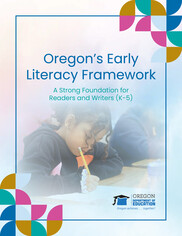|
As we close out this academic year, please join us in celebrating your work addressing unfinished learning and boosting achievement for students in Oregon. The Oregon Department of Education (ODE) is grateful for all districts do to ensure Oregon students are learning and thriving. Also, thank you for all your attention to planning and implementation of the Elementary and Secondary School Emergency Relief III (ESSER III) Fund. Here are a few key ESSER reminders, deadlines, highlights from state ESSER investments, and success stories:
1. No Indirect Rate on Capital Expenditures
Please note that both federal and State of Oregon procedures and policies do not allow indirect rates for administration to be applied to any capital project or other 'distorting costs'. Please find our updated capital expenditure form.
2. Awareness of Davis-Bacon Fair Wage Requirements
All remodeling, renovation, repairs, and new construction (other than basic maintenance and repair), costing more than $2,000 must comply with the Davis-Bacon Prevailing Wage Requirements. Specifically, all contractors and subcontractors must be paid no less than the prevailing wages in the LEA’s area and submit weekly certified payroll.
- See more about prevailing wage determination.
- There are specific recordkeeping, reporting, notice and poster requirements including weekly pay statement documentation for at least three years following the project completion. Read these requirements.
If your district has an ongoing or completed project, please review your contracts and records to make sure prevailing wages were paid. There is no time limit on looking back for compliance.
3. Participation Data Collection Reminder
Starting with this most recent school year (2022-23), you will be asked to gather and report on additional student eligibility and participation data, including student demographic information, for the following activities that are paid for in whole or in part with any ESSER funds:
- Summer School or Enrichment
- Extended Instructional Time
- After School Programs
- High-Dosage Tutoring
- Early Childhood Education
- Purchasing Education Technology
If a student has attended 50% or more of the time, they should be counted as participating. Starting in the fall, you will be able to report on demographic eligibility and participation data to ODE in one of two ways:
- Option 1: Report SSIDs for eligible and participating students per activity.
- Option 2: Report aggregate student demographic groups per activity.
For more information on this topic, see the Fall 2022 ESSER Data Gathering Office Hours PowerPoint. Please contact the ODE.ESSER@ode.oregon.gov email with any questions.
Funds must be spent by 9/30/23 (for ESSER II) or 9/30/24 (for ESSER III). We encourage districts to start their capital expenditure projects as soon as possible due to continued materials and labor shortages. If you have a capital expenditure project that you expect to go beyond the above dates, please contact us immediately.
|
|
ESSER II
|
ESSER III
|
|
(CRRSA Act)
|
(ARP Act)
|
|
Award Period
|
03/13/20 - 09/30/22
|
03/13/20 - 09/30/23
|
|
Deadline for Final Spending (with Tydings Extension)
|
9/30/2023
|
9/30/2024
|
|
Deadline for Claiming Funds in EGMS and Filing Reimbursement
|
November 14, 2023
|
November 14, 2024
|
We are excited to highlight two of the 12 projects Oregon has designated as an ESSER III Set-Aside Investment below. Narratives about Oregon’s full plan for the state’s allocation of ESSER III Set-Aside funds.
 |
|
Key ESSER III Investment #7:
K-5 Literacy Investment $4 Million
|
Project #1 - ODE Releases Oregon’s Early Literacy Framework: A Strong Foundation for Readers and Writers (K-5)
In the spirit of helping pave the way for future literacy leadership, we are reaching out to share with you the final version of Oregon’s Early Literacy Framework: A Strong Foundation for Readers and Writers (K-5). This statewide resource provides coherence, clarity, and common ground for high-quality, comprehensive early literacy education. An overview of the framework is also available.
Oregon’s Early Literacy Framework elevates critical elements of comprehensive literacy instruction: fostering students’ sense of belonging in school, instruction grounded in the science of reading, culturally responsive teaching, and a focus on serving all students, inclusive of multilingual students, students experiencing disabilities, and students with dyslexia. It also emphasizes the essential partnerships with families and caregivers, communities, tribes, community-based organizations, and education service districts to ensure children’s literacy success.
If HB 3198 passes this session, it would provide additional resources to help Oregon schools improve literacy outcomes, building professional learning and core implementation planning steps from Oregon’s Early Literacy Framework. ODE is investing in the development of Oregon’s Early Literacy Framework as part of its commitment to addressing unfinished learning and supporting literacy education infrastructure for the long term.
We look forward to sharing further resources in August, including a slide deck to share with school boards and the community, FAQs, and other resources that will soon be available on the Oregon’s Early Literacy Framework webpage. Please share questions regarding Oregon’s Early Literacy Framework to k5.literacy@ode.oregon.gov.
 |
|
Key ESSER III Investment #9:
Jump Start Kindergarten $11.2 Million
|
Project #2 - ODE Releases Jump Start Kindergarten Toolkit: Resources for Implementing a High-Quality Summer Kindergarten Transition Program
We are excited to release the Jump Start Kindergarten Toolkit: Resources for Implementing a High-Quality Summer Kindergarten Transition Program. For families and young children, the transition into kindergarten is a major milestone. Jump Start Kindergarten aims to ease the transition by giving children and families an opportunity to adjust to new routines, acclimate to a new building, and begin building relationships with staff and other families – all before the first day of school. Many schools and districts across the state contributed to the toolkit, which offers a range of resources to shape the planning and implementation of joyful, high-quality summer transition programs. For more information, visit the Jump Start Kindergarten website. The toolkit is a companion document to the Summer Learning Best Practice Guide and the Summer Learning Toolkit.
|